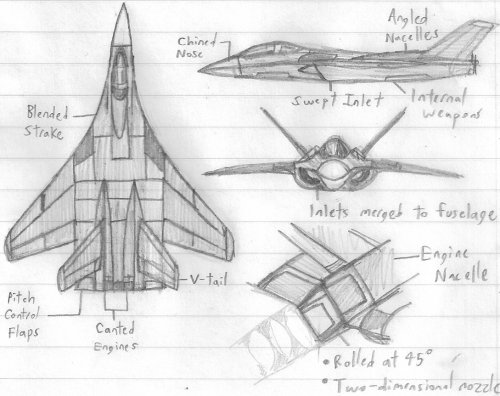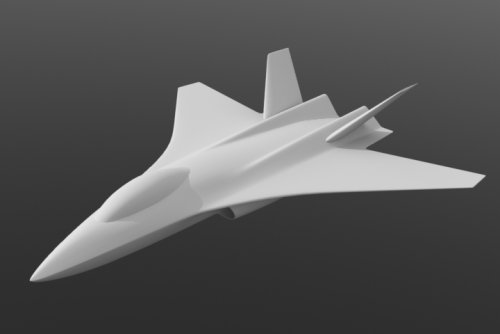Kryptid
ACCESS: Secret
- Joined
- 12 March 2009
- Messages
- 282
- Reaction score
- 52
Not so much a theoretical project as a theoretical visualization of a project.
The pre-final ATF design by Rockwell is pretty well-known (the one with highly-blended strakes and widely-spaced engines): http://www.secretprojects.co.uk/forum/index.php/topic,331.15.html
To my knowledge, the final "stealthy" design was never shown to the public.
The idea behind this thread is...would anyone be interested in helping me develop a speculative image on this design? I will post some sketches, and you give me critique on what looks good and what to change. Or you can do drawings of your own if you wish.
In Dr. Daniel P. Raymer's biography, he gives a few details on how it may have looked. These tidbits could prove useful. Here are a few of the quotes he gives about it:
The pre-final ATF design by Rockwell is pretty well-known (the one with highly-blended strakes and widely-spaced engines): http://www.secretprojects.co.uk/forum/index.php/topic,331.15.html
To my knowledge, the final "stealthy" design was never shown to the public.
The idea behind this thread is...would anyone be interested in helping me develop a speculative image on this design? I will post some sketches, and you give me critique on what looks good and what to change. Or you can do drawings of your own if you wish.
In Dr. Daniel P. Raymer's biography, he gives a few details on how it may have looked. These tidbits could prove useful. Here are a few of the quotes he gives about it:
We have a 3-view of the original design, so that helps.Eventually, we reasoned that if we kept the overall design planform (shadow) about the same, and kept the area distribution from nose to tail about the same, and didn't do anything hugely stupid, then the aerodynamics would be about the same.
Engines are apparently closely-spaced now (perhaps like the F-22?).The engines got pulled in alongside the fuselage, and the inlet ducts were tucked into "armpits" in a reshaped forward fuselage.
Seems that it had aft-strakes/a backporch configuration. I presume that the vertical tails are placed at the edges of these strakes.We ran a sharp strake down the side of the aft fuselage to keep the shadow of the airplane the same. Made the back end of the strake a movable pitch control flap, replacing the movable flap we'd had between the nozzles.
They were all-moving in the original design, so for performance's sake, I imagine the final design had all-moving tails also.We kept our V-tails for stealth and drag.
This is a bit harder for me to visualize. Would these be "armpit" semi-conical inlets similar to those on the F-111, but perhaps integrated with a canted fuselage side?So, we stuck with the efficient conical inlet we'd been using, but sliced it at an angle for better stealth.
Rolled sideways? So the nozzles would be horizontally opened and closed? The opposite of the F-22?By now, though, the engine companies were favoring a double-ramp square nozzle that was eventually used on the F-22, so we switched. This was rolled sideways in our design so that we didn't have to build big wedge-shaped fairings to cover the flat sides.
F-23 wings suggest to me that it had diamond wings with leading edges and trailing edges being equal and opposite in sweep. Same sweep as in the original proposal?I do remember that when the Dem/Val winners were unveiled, I thought it was amusing that our design had looked somewhat like the F-22 fuselage but with F-23 wings and tails.

























